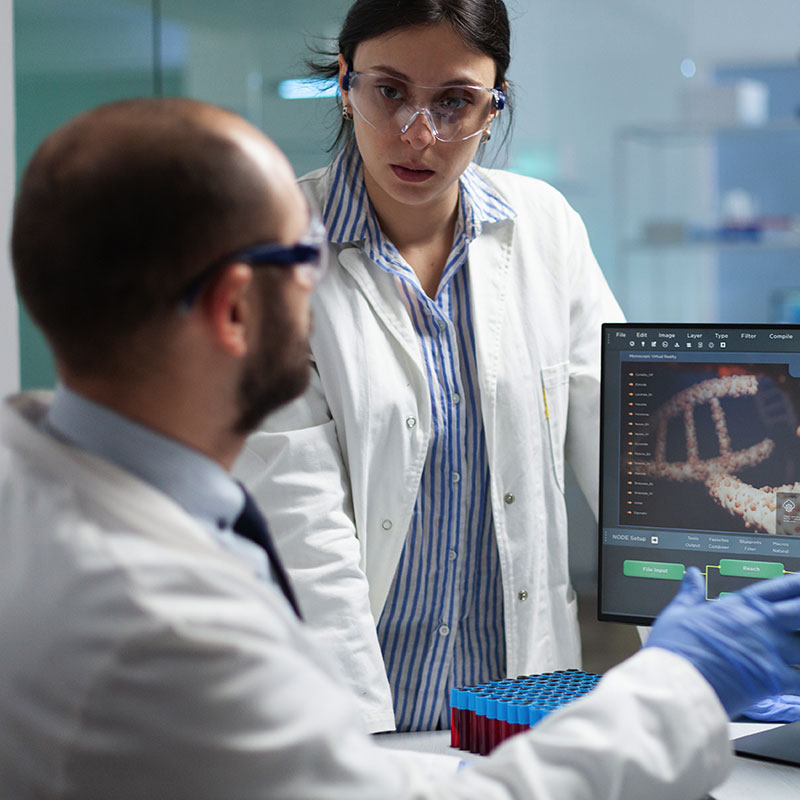GlycoLocate™:
A groundbreaking patent pending platform for early cancer detection.
AOA Dx is pioneering the field of glycolipids
Tumor marker gangliosides are a novel class of biomarkers. Gangliosides are a subclass of sugar-containing glycolipids found in cell membranes. While gangliosides are present in all cells, tumor cells possess a distinct signature of gangliosides compared to normal cells. Originating in tumor tissue, these targets are stable and present throughout cancer formation, development, and relapse. Given their persistent and homogeneous expression almost exclusively in cancer, tumor marker gangliosides are promising targets to be exploited as biomarkers.

The GlycoLocate™ Platform is the future
The GlycoLocate™ platform will be the first of its kind to use multi-omics, including novel tumor marker gangliosides, and advanced computational biology algorithms to diagnose early-stage cancers by using a non-invasive blood test.
Early cancer detection,
re-imagined
Our AI-enabled GlycoLocate™ platform will be the first and only to harness the power of tumor marker gangliosides, combined with other complementary biomarkers, to detect cancer earlier, enabling more patients to get access to life-saving treatments sooner. The GlycoLocate™ platform may differentiate between cancers down to their tissue of origin in both symptomatic and non-symptomatic patients. This superior breakthrough technology removes the typical barriers of cost, invasiveness, accessibility, and effectiveness seen with current early detection technologies.


Glycomics of tumor marker gangliosides are the next frontier in early cancer detection
To date, genomics and proteomics have been used as tools in precision medicine. The active role of tumor marker gangliosides during cancer development, combined with complimentary biomarkers, makes them specific and etiological biomarkers of malignancy. AOA Dx foresees multi-omic, multi-modal platforms powered by AI as the next frontier used for diagnosis, prognosis, monitoring and ultimately targeted therapies. With many cancers, including ovarian, breast, lung, melanoma and neuroblastoma expressing these unique gangliosides in even the earliest stages, AOA Dx’s platform can be harnessed across a variety of indications. Identification of markers through the GlycoLocate™ platform will allow earlier and more accurate detection of cancer, changing the face of early cancer detection.
Ovarian cancer is just the start for AOA Dx and the GlycoLocate™ platform
Developing the platform in collaboration with leading world experts and scientists in conjunction with state-of-the-art data science, we believe we can change the paradigm of early diagnosis of many of the world’s deadliest cancers.
The GylcoLocate™ platform is changing the world of cancer detection to diagnose patients earlier and keep them with their loved ones longer. Find out how AKRIVIS GD™ is transforming women’s health through early ovarian cancer detection
Sources
Nejatie, A., Yee, S. S., Jeter, A. & Saragovi, H. U. The cancer glycocode as a family of diagnostic biomarkers, exemplified by tumor-associated gangliosides. Front Oncol 13, 1261090 (2023). https://doi.org:10.3389/fonc.2023.1261090
Yu, R. K., Tsai, Y. T., Ariga, T. & Yanagisawa, M. Structures, biosynthesis, and functions of gangliosides–an overview. J Oleo Sci60, 537-544 (2011). https://doi.org:10.5650/jos.60.537
Galan, A. et al. GD2 and GD3 gangliosides as diagnostic biomarkers for all stages and subtypes of epithelial ovarian cancer.Front Oncol 13, 1134763 (2023). https://doi.org:10.3389/fonc.2023.1134763
Groux-Degroote, S., Rodriguez-Walker, M., Dewald, J. H., Daniotti, J. L. & Delannoy, P. Gangliosides in Cancer Cell Signaling.Prog Mol Biol Transl Sci 156, 197-227 (2018). https://doi.org:10.1016/bs.pmbts.2017.10.003
Caldwell, S. et al. Mechanisms of ganglioside inhibition of APC function. J Immunol 171, 1676-1683 (2003). https://doi.org:10.4049/jimmunol.171.4.1676
Tong, W., Maira, M., Gagnon, M. & Saragovi, H. U. Ligands Binding to Cell Surface Ganglioside GD2 Cause Src-Dependent Activation of N-Methyl-D-Aspartate Receptor Signaling and Changes in Cellular Morphology. PLoS One 10, e0134255 (2015). https://doi.org:10.1371/journal.pone.0134255
Chen, Y. X. et al. Effect of tumor gangliosides on tyrosine phosphorylation of p125FAK in platelet adhesion to collagen. Oncology reports 29, 343-348 (2013). https://doi.org:10.3892/or.2012.2092
Shibuya, H. et al. Enhancement of malignant properties of human osteosarcoma cells with disialyl gangliosides GD2/GD3.Cancer Sci 103, 1656-1664 (2012). https://doi.org:10.1111/j.1349-7006.2012.02344.x
Webb, T. J. et al. Molecular identification of GD3 as a suppressor of the innate immune response in ovarian cancer. Cancer Res72, 3744-3752 (2012). https://doi.org:10.1158/0008-5472.CAN-11-2695
Orsi, G. et al. GD2 expression in breast cancer. Oncotarget 8, 31592-31600 (2017). https://doi.org:10.18632/oncotarget.16363
Liang, Y. J. et al. Interaction of glycosphingolipids GD3 and GD2 with growth factor receptors maintains breast cancer stem cell phenotype. Oncotarget 8, 47454-47473 (2017). https://doi.org:10.18632/oncotarget.17665
Yoshida, S. et al. Ganglioside G(D2) in small cell lung cancer cell lines: enhancement of cell proliferation and mediation of apoptosis. Cancer Res 61, 4244-4252 (2001).
Hamamura, K. et al. Functional activation of Src family kinase yes protein is essential for the enhanced malignant properties of human melanoma cells expressing ganglioside GD3. J Biol Chem 286, 18526-18537 (2011). https://doi.org:10.1074/jbc.M110.164798
Ladisch, S. et al. Shedding of GD2 ganglioside by human neuroblastoma. Int J Cancer 39, 73-76 (1987). https://doi.org:10.1002/ijc.2910390113
Balis, F. M. et al. The ganglioside G(D2) as a circulating tumor biomarker for neuroblastoma. Pediatr Blood Cancer 67, e28031 (2020). https://doi.org:10.1002/pbc.28031
Schulz, G. et al. Detection of ganglioside GD2 in tumor tissues and sera of neuroblastoma patients. Cancer Res 44, 5914-5920 (1984).
